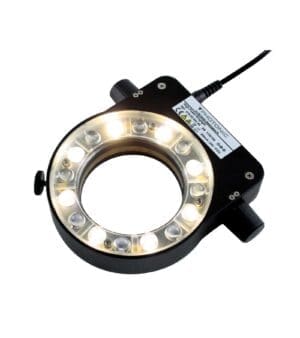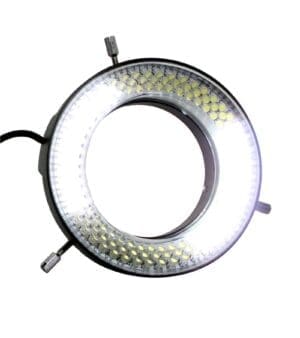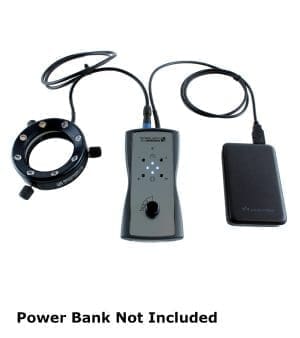LED Ring lights are strips of illuminators (LED or SMD bulbs) encased in a protective housing, positioned in a circular configuration. They are especially prominent in stereo microscopy for providing oblique incident light (from above) to the object being viewed. However, they can also be used in vision systems and general photography. Their primary function is to evenly illuminate the subject, without adding shadows, or reflections, producing clear images.
They are mounted concentrically at the end of the lens with a simple clamp or screw thread. They can be added to virtually any lens, with a smorgasbord of ring lights available.
There are various ring light configurations and many specification options available to users. These properties need to be carefully considered when adding to a stereo microscope or vision system. It’s important the ring light works in conjunction with the optical and physical properties of the system, and the sample type. These features have been explored below, and their proper evaluation is essential for creating an efficient imaging system.
Clamping Diameter: The physical size of the ring light also referred to at the inner diameter. It’s important to match this with the physical size of the lens it’s being mounted to. The ring light needs to be concentrically mounted to the lens to perform optimally. Typically, stereo microscopes have a clamping diameter of 66mm ø. This can vary so it’s best to check. There are many clamping diameters available to suit different lenses. There are also adapters and converters to change this.
Working Distance: This is often overlooked but ring lights like lenses have a working distance. This will be a length (or range) advised in mm, where the light is optimised evenly over the sample. It is important to match the working distance of the optics and the ring light, as closely as possible to achieve the best results.
Segmentation: It’s possible to illuminate separate sections of a ring light to change the intensity or illumination angle of the light. This is helpful to emphasise certain sample characteristics like topography or defects such as scratches or dents in metals. This extra control over can be useful deepening on sample type.
LED Qty & External Diameter: In addition to the internal or clamping diameter of the ring, it’s important to consider how many LED’s are in the array, and it’s physical size.
Colour Temp: Options are available for different white light colour temperatures or Kelvin factors. These will make a difference to how the sample appears and renders colour, and would be used in conjunction with white balance of a camera. Higher kelvin factors appear whiter, and lower factors are yellower in appearance.
Wavelength: It is possible to have ring lights with different light colours and wavelengths if these are required and can improve sample appearance in some applications. UV and IR wavelength ring lights are available, for applicable samples, and can add value to a system.
We offer some typical ring lights for stereo microscopy and vision systems here, but there are too many options available to list them all. Please contact us with your specific ring light requirements and we can configure and quote the best one for your application.






